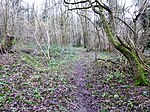Alkham, Lydden and Swingfield Woods
Forests and woodlands of KentNature Conservation Review sitesSites of Special Scientific Interest in Kent

Alkham, Lydden and Swingfield Woods is a 228.3-hectare (564-acre) biological Site of Special Scientific Interest north-west of Dover in Kent. Alkham Valley Woods is a Nature Conservation Review site, Grade I.This site is composed of several steeply sloping woods on chalk soil, together with an area of chalk grassland. The ground flora is diverse, including some unusual plants such as lady orchid in the woods and burnt orchid in the meadow.Public footpaths go through some of the woods but other areas are private land.
Excerpt from the Wikipedia article Alkham, Lydden and Swingfield Woods (License: CC BY-SA 3.0, Authors, Images).Alkham, Lydden and Swingfield Woods
Greenwich Lane,
Geographical coordinates (GPS) Address Nearby Places Show on map
Geographical coordinates (GPS)
| Latitude | Longitude |
|---|---|
| N 51.148 ° | E 1.23 ° |
Address
Greenwich Lane
Greenwich Lane
CT15 7EA
England, United Kingdom
Open on Google Maps








